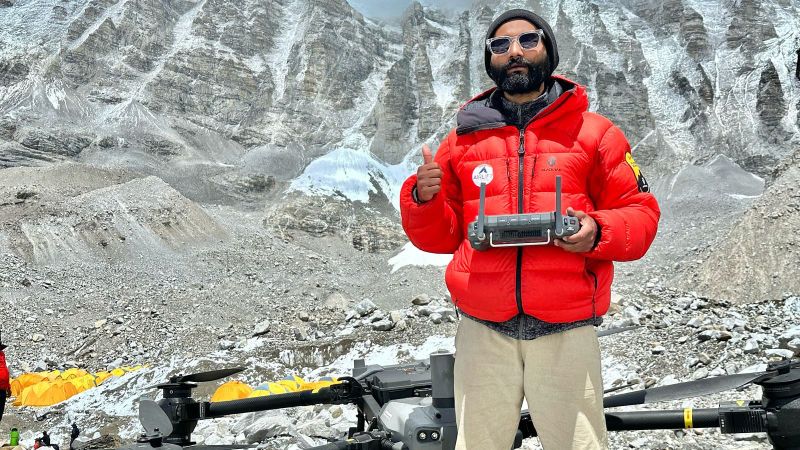New Delhi, India
CNN
Revamping Everest Climbing with Drones
In the serene atmosphere of towering peaks and pristine glaciers, an unusual sound interrupts the quiet — a ladder suddenly descends from above. Milan Pandey, a drone pilot at Everest Base Camp, is witnessing breathtaking views that few have encountered, all without needing climbing gear. His innovative approach utilizing drones promises to transform operations on the world’s highest mountain.
Using drones, Pandey can deliver essential items such as ladders, ropes, and oxygen tanks to Sherpas and “icefall doctors” working at Khumbu Icefall, enhancing safety on the mountain. Sherpas have been guiding climbers on Everest for 70 years, with many having tragically lost their lives in pursuit of helping climbers reach the summit. Pandey, through Airlift Technology, aims to ensure safer journeys by marrying the technical capabilities of drones with the traditional expertise of Sherpas.
Base Camp sits at an altitude of approximately 5,364 meters (17,598 ft) and Camp One at about 6,065 meters (19,900 ft). While it takes Sherpas six to seven hours to traverse the roughly 1.8-mile stretch between the two, drones can accomplish the same journey in just minutes.
Recognizing the potential of this technology after a devastating avalanche claimed the lives of his friends, Mingma G Sherpa from Imagine Nepal sought aid through drone assistance for safer navigation. Meanwhile, Raj Bikram, CEO of Airlift Nepal, collaborated with local authorities to implement drone technology for 3D mapping Everest, leading to successful test flights with support from DJI drones.
In early drone operations, the team faced challenges such as high altitude and variable weather conditions, but they successfully completed their first cleanup mission, removing around 1100 pounds of waste from Camp One to Base Camp. For the upcoming 2025 climbing season, Airlift Technology aims to facilitate equipment transport and aid in waste management efforts.
As drones become an integral part of climbing logistics, the Sherpas communicate their needs via walkie-talkie, allowing timely delivery of equipment and even lifesaving supplies. Although financial constraints and logistical challenges remain, the potential for increased safety and efficiency is clear, fostering a hope that this innovation can revitalize interest in the high-stakes profession of climbing.
The Future of Climbing
As the first groups of climbers arrive for the 2025 season, the incorporation of drone technology is recognized as part of the climbing evolution. Experts highlight that advancements in technology historically have improved safety for climbers and Sherpas alike. Drones are seen as a responsible extension of this legacy, supporting the enduring spirit of exploration and adventure without diminishing the challenges of climbing.



